Related Research Articles
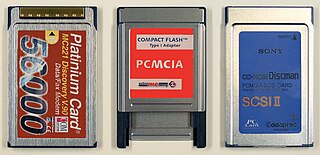
PC Card is a parallel peripheral interface for laptop computers and PDAs. The PCMCIA originally introduced the 16-bit ISA-based PCMCIA Card in 1990, but renamed it to PC Card in March 1995 to avoid confusion with the name of the organization. The CardBus PC Card was introduced as a 32-bit version of the original PC Card, based on the PCI specification. The card slots are backward compatible for the original 16-bit card, older slots are not forward compatible with newer cards.

The Memory Stick is a removable flash memory card format, originally launched by Sony in late 1998. In addition to the original Memory Stick, this family includes the Memory Stick PRO, a revision that allows greater maximum storage capacity and faster file transfer speeds; Memory Stick Duo, a small-form-factor version of the Memory Stick ; the even smaller Memory Stick Micro (M2), and the Memory Stick PRO-HG, a high speed variant of the PRO to be used in high-definition video and still cameras.

A memory card is an electronic data storage device used for storing digital information, typically using flash memory. These are commonly used in digital portable electronic devices, such as Digital cameras as well as in many early games consoles such as the Nintendo Wii. They allow adding memory to such devices using a card in a socket instead of protruding USB flash drives.

CompactFlash (CF) is a flash memory mass storage device used mainly in portable electronic devices. The format was specified and the devices were first manufactured by SanDisk in 1994.

Secure Digital, officially abbreviated as SD, is a proprietary, non-volatile, flash memory card format the SD Association (SDA) developed for use in portable devices.
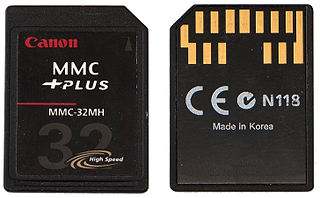
MultiMediaCard, officially abbreviated as MMC, is a memory card standard used for solid-state storage. Unveiled in 1997 by SanDisk and Siemens, MMC is based on a surface-contact low pin-count serial interface using a single memory stack substrate assembly, and is therefore much smaller than earlier systems based on high pin-count parallel interfaces using traditional surface-mount assembly such as CompactFlash. Both products were initially introduced using SanDisk NOR-based flash technology.

A flash drive is a data storage device that includes flash memory with an integrated USB interface. A typical USB drive is removable, rewritable, and smaller than an optical disc, and usually weighs less than 30 g (1 oz). Since first offered for sale in late 2000, the storage capacities of USB drives range from 8 to 256 gigabytes (GB), 512 GB and 1 terabyte (TB). As of 2023, 2 TB flash drives were the largest currently in production. Some allow up to 100,000 write/erase cycles, depending on the exact type of memory chip used, and are thought to physically last between 10 and 100 years under normal circumstances.
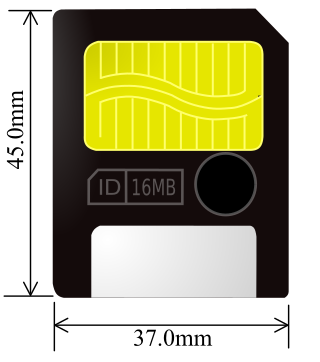
SmartMedia is an obsolete flash memory card standard owned by Toshiba, with capacities ranging from 2 MB to 128 MB. The format mostly saw application in the early 2000s in digital cameras and audio production. SmartMedia memory cards are no longer manufactured.
This table provides summary of comparison of various flash memory cards, as of 2017.

A memory card reader is a device for accessing the data on a memory card such as a CompactFlash (CF), Secure Digital (SD) or MultiMediaCard (MMC). Most card readers also offer write capability, and together with the card, this can function as a pen drive.
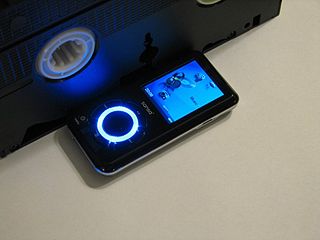
The Sansa e200 series is a portable media player developed by SanDisk and released on January 5, 2006. The device is available in four capacities of Flash memory: 2 GB (e250), 4 GB (e260), 6 GB (e270), and 8 GB (e280). All players have a 1.8-inch, TFT LCD display with a resolution of 176 by 220 pixels. Certain files, if not in a format accepted by the player's original firmware, must first be converted with the Sansa Media Converter Windows software. This will convert images to bitmap format (.bmp) and videos to MJPEG, for v1 models. On v2 players it will convert videos to DivX and simply resize images. It is not possible to simply copy videos to the device, even if they seem to be in the correct format; trying to access them displays an error message.

SanDisk has produced a number of flash memory-based digital audio and portable media players since 2005. The current range of products bears the SanDisk Clip name. SanDisk players were formerly marketed under the Sansa name until 2014.
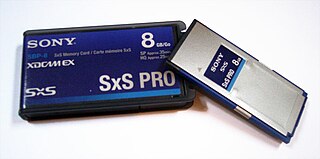
SxS (S-by-S) is a flash memory standard compliant to the Sony and SanDisk-created ExpressCard standard. According to Sandisk and Sony, the cards have transfer rates of 800 Mbit/s and burst transfer rate of up to 2.5 Gbit/s over the ExpressCard's PCI Express interface. Sony uses these cards as the storage medium for their XDCAM EX line of professional video cameras.
The SD Association (SDA) is an American nonprofit organization that sets standards for the SD memory card format. SanDisk, Panasonic (Matsushita), and Toshiba formed the SD Association in January 2000. In 2010, the SDA had approximately 1,000 member companies involved in the design and development of SD standards. Thousands of device models and hundreds of products across dozens of product categories integrate the small, removable memory cards.
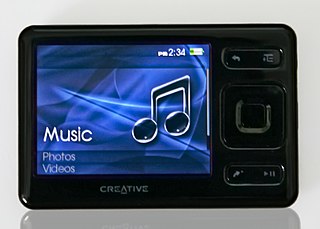
The ZEN is a portable media player designed and manufactured by Creative Technology. This flash memory-based player is the de facto successor of the ZEN Vision:M and was announced on August 29, 2007, to be available in capacities of 2, 4, 8, and 16 GB, as of September 14. A 32 GB model was announced on December 4, 2007, setting a record for storage capacity among flash players. The ZEN is referred to also by the identifier DVP-FL0001 though this does not appear on the unit.

The Sansa Fuze is a portable media player developed by SanDisk and released on March 8, 2008. The Fuze is available in three different Flash memory capacities: 2 GB, 4 GB, and 8 GB and comes in six different colors: black, blue, pink, red, silver, and white. Storage is expandable via a microSDHC slot with capacity up to 32 GB, and unofficially to 64 GB or more via FAT32 formatted SDXC cards. All models have a 1.9 inch TFT LCD display with a resolution of 220 by 176 pixels and a built-in monaural microphone and FM tuner; recordings of the latter two are saved as PCM WAV files.
slotMusic was a brand of microSD memory card developed by SanDisk preloaded with music in MP3 format. They were first available at Wal-Mart and Best Buy stores in October 2008. The current selection of songs comes from Universal Music Group, Sony BMG, Warner Music Group and EMI Music. As of mid-2011, SanDisk's website lists a total of 14 albums available in the SlotMusic format.
slotRadio was a proprietary format developed by SanDisk that delivered music on a microSD memory card. Up to 1,000 songs were preloaded on microSD cards which were DRM protected. Users had no direct access to the music to copy songs, organize playlists, or download the songs from the card. Songs could only be played using a SanDisk Sansa music player that supported the SlotRadio formatted microSD cards.

The XQD card is a memory card format primarily developed for flash memory cards. It uses PCI Express as a data transfer interface.

CFexpress is a standard for removable media cards proposed by the CompactFlash Association (CFA). The standard uses the NVM Express protocol over a PCIe 3.0 interface with 1 to 4 lanes where 1 GB/s data can be provided per lane. There are multiple form factors that feature different PCIe lane counts. One of the goals is to unify the ecosystem of removable storage by being compatible with standards already widely adopted, such as PCIe and NVMe. There already is a wide range of controllers, software and devices that uses these standards, accelerating adoption.
References
- ↑ Singer, Michael. "SanDisk stakes its future on TrustedFlash". CNET. Retrieved 2019-01-21.
- 1 2 "Sandisk Targets 'Gruvi' Music Card At Mobiles". InformationWeek. Retrieved 2019-01-21.[ permanent dead link ]
- ↑ "SanDisk unveils 'slotMusic,' a flash-based competitor to CD music". BetaNews. 22 September 2008. Retrieved 2019-01-21.